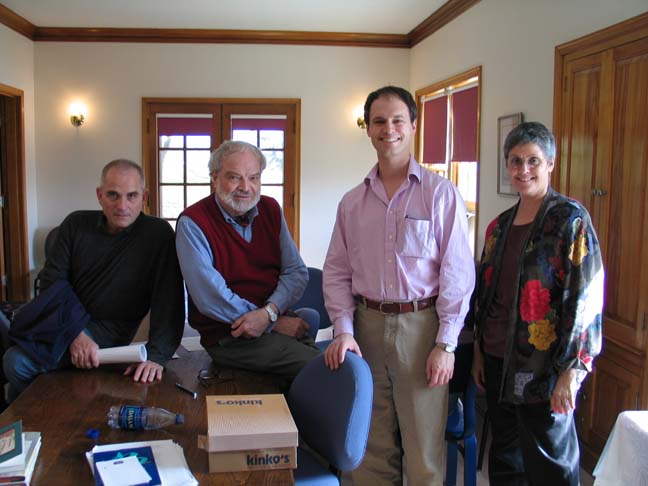(L-R) Stan Lombardo, Kenneth Irby, Jordan Davis & Judy Roitman
at the
photo by Jonathan Mayhew
If the editor’s first function is to offer context, then Black Spring’s Winter 2005 “Lawrence Issue,” jointly edited it would seem by Steve Tills & Jim McCrary, demonstrates exactly how much context can contribute. Indeed, Black Spring is almost a test case, given just how quirky its production is. The publication has no masthead, nor issue & volume number, so I’m drawing the conclusion that Tills is the co-editor and publisher here primarily on the facts (a) that Tills has a weblog by the same name (which he “shares” with Menno ter Braak, a Dutch essayist & fiction writer who committed suicide in 1940), (b) he’s in the issue, (c) the publisher is listed as theenk Books, the first word always lower case, a neologism that shows up in the URL to the weblog, and finally (d) the press lists an upstate New York address, which is where Tills lives. McCrary at least is mentioned as co-editor in the contributors’ notes.
But if the journal’s editorial structure has to be fathomed out, its editorial focus is crystal clear – virtually the entire issue is devoted to the poetry scene of
A sociologist would probably identify this scene as revolving around three poets in particular – Ken Irby, Jim McCrary & John Moritz – who share close ties with the post-avant tradition in general & the projectivist side of the New American Poetry in particular. But it also revolved, for awhile at least, around Tansy Bookstore – the Olson allusion is no accident – originally run by Moritz & later by visual artist Lee Chapman & others. It’s worth noting here that Kansas has always had strong ties to the avant & post-avant worlds – Langston Hughes was a boy here & William Burroughs spent his final years tending his garden in
The post-avant – and especially the projectivist orientation – I think must have had a huge impact in inoculating Lawrence poets generally from any anxieties as to the indifference of the university – an inescapable institutional presence in a town this small – since it was self-evident that a small & continually collapsing alternative phenomenon like Black Mountain College had far more impact on the arts in America than, say, Harvard & Yale combined.
Now, with some “new blood” in town in the form of Jonathan Mayhew & Judy Roitman, it seems quite clear that
In general, the issue divides into poetry by the
The other feature that jumps out at a reader – it’s so distinct that it can’t possibly be accidental – is how personal these critical pieces are. Baptiste-Chirot feels compelled to tell us that he’s never been to
Mr. Irby, then, is not an oyster, any more than I am what I may have sometime, allegedly, ate.
And yet, staring at him, straight ahead . . . the ‘massive brow’ . . . those ‘curly locks’!! –- the eye, the eyes, the ‘almost human’ . . .
underline & ellipses in original
Grenier goes on to consider the ways in which Irby is like or unlike a bison. At the same time, Grenier delivers a perfectly serious & deeply insightful reading of Irby’s work, concluding
One result of Irby’s writing will be that people are going to have to read Bryant & Whittier again, & even Longfellow –- i.e. include a lot of stuff shut out by recent snotty Europeanizers as right here, weirdly present (‘symbolist’) American mainstream.
I would argue that this conclusion, while not unwarranted, dismisses a little too easily all of Irby’s work translating Pasternak, that there may be a bit more of the “oyster” here than meets Grenier’s eye. Yet where I agree completely¹ is that Irby’s use of sound, silence & sentence structure will force a close reader to reconsider, reimagine, everything:
silence in the world is what is most characteristic -- the inwardness of objects not apparent as ‘proprioception’ in human beings . . .
Because of such deeply personal considerations, I’m struck with how different Irby appears in Grenier’s piece, in Baptiste-Chirot’s & in Ellis’. I don’t, in fact, think that any of them are wrong, but rather that such personal reading turns up facets that have as much to do, not with Irby per se, but rather with how this poet & poems interact with different readers. The sum is quite a bit more than just three separate readings.
One could make, I think, the same argument with regards to the three readings given McCrary’s poetry here as well, although the tone – at least for Ellis & Smith Nash – is a little more formal, perhaps because they’re making the case for this writer who is largely not known to the wider world – McCrary’s books in recent years have been mostly, if not entirely, self published & given away. Which leaves Tills in something of the same position as Grenier with regards to Irby, the teller of the deeply personal reading.
Regardless of which McCrary you confront, he is the author of texts that are clean & stripped to essentials in a way that one might associate with such NAP figures as Phil Whalen, Cid Corman, Joanne Kyger or Larry Eigner:
Suddenly
From another direction
The wind is confusing
The text printed here, “Notes from Isla Holbox – 2004,” is a journal of a trip to Quintana Roo, yet more directly it is an account of attention:
How can you possibly
Define a
Visit
Was it the
Weight of the
Air
Is that worth
Mention
Any community that can generate poetry of this order will never have to worry about being vibrant or healthy.
¹ Indeed, our enthusiasm for Irby’s poetry was one of the key agreements around which Grenier & I first came together some 35 years ago, every bit as much as our shared enthusiasm for Zukofsky, Stein, Creeley or Watten.






